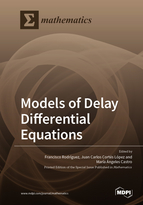Models of Delay Differential Equations
A special issue of Mathematics (ISSN 2227-7390). This special issue belongs to the section "Difference and Differential Equations".
Deadline for manuscript submissions: closed (31 December 2020) | Viewed by 28268
Special Issue Editors
Interests: delay differential equations; diffusion and heat conduction models with delay; mathematical biology
Special Issues, Collections and Topics in MDPI journals
Interests: differential equations with randomness; mathematical modelling
Special Issues, Collections and Topics in MDPI journals
Interests: delay differential equations; numerical methods; non-Fourier heat conduction models
Special Issues, Collections and Topics in MDPI journals
Special Issue Information
Dear Colleagues,
Models of differential equations with delay have pervaded many scientific and technical fields in the last decades. The use of delay differential equations (DDE) and partial delay differential equations (PDDE) to model problems with the presence of lags or hereditary effects have demonstrated a valuable balance between realism and tractability. Of special interest in recent years is the development and analysis of models with interactions between delay and random effects, through the use of stochastic and random delay differential equation (SDDE and RDDE). In this Special Issue, we are inviting submissions of original papers dealing with the theory and applications of differential equations with delay (DDE, PDDE, SDDE, and RDDE), including, but not limited to, construction of exact solutions, numerical methods, dynamical properties, and applications to mathematical modeling of phenomena and processes in biology, medicine, economics, engineering, and the social sciences.
Prof. Dr. Francisco Rodríguez
Prof. Dr. Juan Carlos Cortés López
Prof. Dr. María Ángeles Castro
Guest Editors
Manuscript Submission Information
Manuscripts should be submitted online at www.mdpi.com by registering and logging in to this website. Once you are registered, click here to go to the submission form. Manuscripts can be submitted until the deadline. All submissions that pass pre-check are peer-reviewed. Accepted papers will be published continuously in the journal (as soon as accepted) and will be listed together on the special issue website. Research articles, review articles as well as short communications are invited. For planned papers, a title and short abstract (about 100 words) can be sent to the Editorial Office for announcement on this website.
Submitted manuscripts should not have been published previously, nor be under consideration for publication elsewhere (except conference proceedings papers). All manuscripts are thoroughly refereed through a single-blind peer-review process. A guide for authors and other relevant information for submission of manuscripts is available on the Instructions for Authors page. Mathematics is an international peer-reviewed open access semimonthly journal published by MDPI.
Please visit the Instructions for Authors page before submitting a manuscript. The Article Processing Charge (APC) for publication in this open access journal is 2600 CHF (Swiss Francs). Submitted papers should be well formatted and use good English. Authors may use MDPI's English editing service prior to publication or during author revisions.
Keywords
- Delay differential equations
- Partial delay differential equations
- Random and stochastic delay differential equations
- Numerical methods
- Exact solutions and dynamical properties
- Diffusion and heat conduction models with delay
- Uncertainty quantification with delay differential equations and simulation
- Models with delay in biology, economics, and engineering







